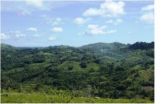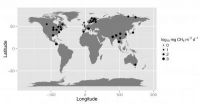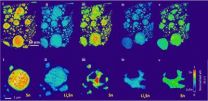Agroforestry systems can repair degraded watersheds
2014-03-27
(Press-News.org) NAIROBI, Kenya. (27 March 2014) ----Agroforestry, combined with land and water management practices that increase agricultural productivity, can save watersheds from degradation.
A study conducted by the World Agroforestry Centre (ICRAF) in the Gabayan watershed in eastern Bohol, Philippines, has shown that agroforestry systems create a more sustainably managed watershed that allows people living there to benefit from the ecosystem. The benefits include higher crop yields, increased income and resilience to climate change.
Agroforestry is an integrated land-use management technique that incorporates trees and shrubs with crops and livestock on farms.
The study, called Modeling the effects of adopting agroforestry on basin scale surface runoff and sediment yield in the Philippines, uses a computer-based Soil and Water Assessment Tool (SWAT) to simulate the effects of different land uses on watershed hydrology and the ecosystem services provided by the Gabayan watershed. The tool predicts the environmental impact of land use, land management practices, and climate change.
Watersheds are areas of land with streams and rivers that all drain into a larger body of water, such as a bigger river, a lake or an ocean. Watersheds not only supply water for domestic use but also provide a multitude of ecological and cultural services, including water for irrigation and industry, shelter, habitats for biodiversity and, in very poor areas, sources of livelihoods.
Over the years, however, many watersheds throughout the world have suffered from intensive resource extraction and mismanagement. In countries like the Philippines, several watershed areas in the country are now degraded due to deforestation and soil erosion.
The Gabayan watershed incorporates a heavily degraded, multi-use landscape covering over 5000 hectares hosting about 60,000 people whose livelihoods depend on subsistence agriculture
Farmers here have reported environmental problems, such as floods, droughts, reductions in water quality and increases in soil erosion and downstream sedimentation of irrigation networks.
"The degraded watershed has been largely deforested and replaced with extensive agricultural and grasslands over the last half century", says David Wilson, the lead researcher. "It has disrupted the evenness of river flow, resulting in alternate flooding and drought episodes, an accelerated level of soil erosion as well as downstream sedimentation".
SWAT was used to simulate the impacts of current land-use practices and conservation agriculture with agroforestry in strategic locations. The study results showed a significant reduction in sediment yield (20%) and sediment concentration (35%)in the Gabayan watershed under agroforestry and conservation agriculture.
The study was therefore able to provide scientific evidence that agroforestry, combined with improved land management practices, are an effective land-use strategy for the watersheds.
"Specifically, the use of restored areas that have vegetation next to water resources and contour planting in grasslands appear to be the most effective techniques to reduce sediment transfer to the watershed river network", says Wilson.
INFORMATION:
The World Agroforestry Centre (ICRAF), headquartered in Nairobi, Kenya and working in 24 countries in Africa, Asia and South America, is the world's leading research institution on the diverse role trees play in agricultural landscapes and rural livelihoods. As part of its work to bring tree-based solutions to bear on poverty and environmental problems, the Centre's researchers – working in close collaboration with national partners – have developed new technologies, tools and policy recommendations for increased food security and ecosystem health. For more information, visit http://www.worldagroforestry.org
ELSE PRESS RELEASES FROM THIS DATE:
Scientists watch nanoparticles grow
2014-03-27
This news release is available in German. With DESY's X-ray light source PETRA III, Danish scientists observed the growth of nanoparticles live. The study shows how tungsten oxide nanoparticles are forming from solution. These particles are used for example for smart windows, which become opaque at the flick of a switch, and they are also used in particular solar cells. The team around lead author Dr. Dipankar Saha from Århus University present their observations in the scientific journal Angewandte Chemie – International Edition.
For their investigation, the scientists ...
Record quantum entanglement of multiple dimensions
2014-03-27
The states in which elementary particles, such as photons, can be found have properties which are beyond common sense. Superpositions are produced, such as the possibility of being in two places at once, which defies intuition. In addition, when two particles are entangled a connection is generated: measuring the state of one (whether they are in one place or another, or spinning one way or another, for example) affects the state of the other particle instantly, no matter how far away from each other they are.
Scientists have spent years combining both properties to construct ...
A more potent greenhouse gas than CO2, methane emissions will leap as Earth warms
2014-03-27
While carbon dioxide is typically painted as the bad boy of greenhouse gases, methane is roughly 30 times more potent as a heat-trapping gas. New research in the journal Nature indicates that for each degree that the Earth's temperature rises, the amount of methane entering the atmosphere from microorganisms dwelling in lake sediment and freshwater wetlands — the primary sources of the gas — will increase several times. As temperatures rise, the relative increase of methane emissions will outpace that of carbon dioxide from these sources, the researchers report.
The findings ...
Researchers reveal the dynamics behind Arctic ecosystems
2014-03-27
Field studies covering three continents show that temperature has an unexpectedly important effect on food-web structure, while the relationship between predator and prey is crucial for the food-web dynamics and thereby the entire ecosystem.
Temperature is decisive
'We have gathered data on all animals and plants characterising the arctic tundra in seven different areas. This has allowed us to generate a picture of how food chains vary over a very large geographical (and, with it, climatic) gradient. Therefore, and for the first time, we can offer an explanation of ...
IRCM researchers uncover a new function for an important player in the immune response
2014-03-27
Montréal, March 27, 2014 – IRCM researchers led by Javier M. Di Noia, PhD, uncovered a new function of AID, a crucial enzyme for the immune response. The discovery, recently published by the scientific journal Proceedings of the National Academy of Sciences (PNAS), helps explain a rare genetic disorder that causes an immunodeficiency syndrome.
The Montréal research team studies the enzyme AID, or activation-induced deaminase, that can be found in B lymphocytes (the group of white blood cells whose main function is to produce antibodies to fight against infections). AID ...
Scientists track 3-D nanoscale changes in rechargeable battery material during operation
2014-03-27
UPTON, NY-Scientists at the U.S. Department of Energy's Brookhaven National Laboratory have made the first 3D observations of how the structure of a lithium-ion battery anode evolves at the nanoscale in a real battery cell as it discharges and recharges. The details of this research, described in a paper published in Angewandte Chemie, could point to new ways to engineer battery materials to increase the capacity and lifetime of rechargeable batteries.
"This work offers a direct way to look inside the electrochemical reaction of batteries at the nanoscale to better understand ...
Dentist shortage bites California as more choose to practice out of state
2014-03-27
A lingering recession, the elimination of Medicaid dental reimbursements and a glut of established dentists in wealthier, populated areas may explain why more new dentists are practicing outside California, according to a new policy brief from the UCLA Center for Health Policy Research.
"Good access to dental care depends on having a robust supply of new dentists in California," said Nadereh Pourat, director of research at the center and lead author of the study. "We need a new generation of dentists to replace the many dentists who are close to retirement." ...
Decline of natural history troubling for science, society
2014-03-27
Support for natural history – the study of organisms, how and where they live and how they interact with their environment – appears to be in steep decline in developed countries, according to Joshua Tewksbury, a University of Washington professor and WWF International scientist.
"Yet natural history provides essential knowledge for fields as varied as human health, food security, conservation, land management and recreation," he said.
Tewksbury and 16 other scientists from across North America outline the importance to society and call for a revitalization of the practice ...
Big data keeps complex production running smoothly
2014-03-27
Large amounts of data are produced when industrial companies monitor their facilities. Sensors check temperature, pressure, power, or energy use data. "If you're scanning to the nearest second, it's easy to rack up several terabytes of information in under a week," says Dr. Olaf Sauer from the automation business unit at the IOSB. But often there is a lack of suitable methods to evaluate the information. "Today's operators use only about seven percent of this data for maintenance or protection from breakdowns," adds Sauer. At the Hannover Messe Digital Factory, IOSB developers ...
One size does not fit all: Dietary guidelines for choline may be insufficient
2014-03-27
What is now considered to be the "right" amount of the essential nutrient, choline, might actually be "wrong," depending on who you are. That's because scientists have found that the "right" amount of choline needed by an individual is influenced by a wide range of factors, including gender, life stage, race and ethnicity of the individual. This means that using the current one-size-fits-all approach to determining a person's vitamin and mineral needs may leave them in less than optimal health. Choline is an essential nutrient used by the body to construct cell membranes ...





